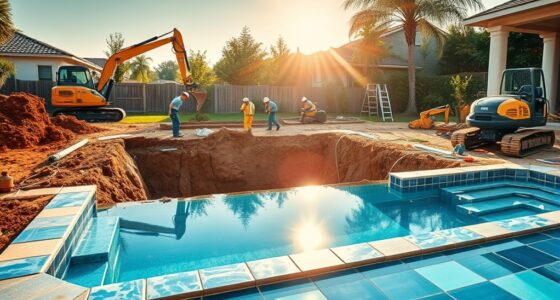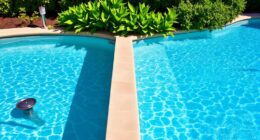To install an above-ground pool, start by choosing a flat, stable area and clearing debris. Assemble the frame according to manufacturer instructions, then fill the pool slowly with a garden hose while checking that everything stays level and secure. Once filled, connect the filtration system, add chemicals for water safety, and perform regular maintenance. For detailed steps and tips, exploring each phase thoroughly will help guarantee your pool setup is safe and successful.
Key Takeaways
- Select a flat, stable site free of debris, and prepare the ground with gravel or concrete for stability.
- Follow manufacturer instructions to assemble the frame and sidewalls securely, ensuring proper alignment.
- Fill the pool slowly with a filtered garden hose, monitoring water level to prevent damage.
- Install the filtration system and skimmers after filling, then add pool chemicals to balance water quality.
- Perform seasonal maintenance and winterization, including proper draining, covering, and debris removal.

Installing an above-ground pool can be a straightforward and rewarding project if you understand the key steps involved. Before diving into the setup, make sure you’re familiar with essential safety practices, especially pool chemical safety. Proper handling and storage of chemicals are vital to prevent accidents and keep your pool safe for everyone. Always read labels carefully, wear protective gear, and store chemicals out of children’s reach. Once your pool is installed and filled, maintaining proper chemical balance will help prevent algae growth and keep the water safe. Regularly testing pH, chlorine, and alkalinity levels ensures the water remains clean and healthy. If you plan to store your pool during the off-season, winterizing above ground pools becomes essential. Proper winterization prevents damage from freezing temperatures and debris buildup. Drain the water to the manufacturer’s recommended level, remove any accessories, and clean the pool thoroughly. Use a winterizing chemical kit if advised, to protect the liner and keep the water chemically balanced during storage. Additionally, incorporating proper maintenance practices can extend the lifespan of your pool equipment and liner. The first step in installation involves preparing a flat, stable surface. You’ll want to clear the area of any rocks, sticks, or debris, ensuring the ground is level. Many choose a compacted gravel or concrete pad for added stability. Once the site is ready, follow the manufacturer’s instructions to assemble the pool frame. Usually, you’ll connect the sidewalls and secure the supports, making sure everything clicks into place firmly. When it’s time to fill the pool, do so slowly to avoid stressing the liner. Use a garden hose with a filter to prevent dirt from contaminating the water. As the water level rises, periodically check that the pool remains level and the walls are undamaged. After filling, install the filtration system and skimmers, then add the appropriate pool chemicals to establish a safe, clean environment. Throughout the season, stay vigilant about pool chemical safety, especially when adding shock or algaecides. Always follow the instructions and wait the recommended time before swimming. Regular maintenance, including cleaning filters and skimming debris, will extend the life of your pool. When the weather turns colder, it’s time to winterize your above ground pool. Proper winterizing not only preserves your investment but also ensures a smooth start-up when spring arrives. Drain the water to the recommended level, disconnect equipment, and cover the pool securely. Use winter covers designed for above-ground pools to keep out snow, leaves, and critters. By following these steps carefully, you’ll enjoy a safe, clean, and well-maintained above-ground pool year after year.
Frequently Asked Questions
How Long Does the Entire Installation Process Typically Take?
You can expect the entire pool installation to take about 1 to 3 days, depending on your experience and site conditions. During setup, you’ll need to take safety precautions and gather pool chemicals for proper maintenance. It’s important to plan ahead, follow instructions carefully, and allow time for filling and testing the pool. Rushing can lead to mistakes, so patience ensures a safe, enjoyable swimming experience.
What Permits or Approvals Are Needed Before Installation?
Before installing your pool, you need to check if you require any permits or approvals. You should review local zoning regulations and homeowner association rules, as they may have specific requirements or restrictions. Contact your city or county building department to determine if a building permit is necessary. Also, verify your pool complies with setback distances and safety standards to avoid potential fines or complications during installation.
Can I Install an Above-Ground Pool on Uneven Ground?
Ever wondered if you can set up your pool on uneven ground? You might need to do some ground leveling first to make certain of stability and safety. Uneven surfaces can cause issues with deck compatibility and pool integrity. Consider grading or adding a solid, level base for the best results. Don’t skip this step, or you risk future problems. Proper preparation guarantees a smooth, enjoyable swimming experience.
What Maintenance Is Required After Installation?
After installing your pool, you’ll need to regularly perform pool cleaning to keep it pristine. This includes skimming debris, vacuuming the floor, and cleaning filters. You also must maintain proper chemical balancing to prevent algae growth and ensure safe water quality. Check chemical levels weekly, adjusting pH, chlorine, and alkalinity as needed. Consistent maintenance keeps your pool enjoyable, safe, and in top condition throughout the season.
Are There Seasonal Considerations for Installation Timing?
Imagine a sunny summer day versus a chilly winter morning—seasonal timing impacts your pool setup. You should consider climate considerations when planning installation, as installing in milder weather reduces risks like freezing or shifting ground. Ideal seasonal timing ensures proper setup, less maintenance, and longer-lasting enjoyment. Avoid early spring or late fall installations to prevent weather-related issues and maximize your pool’s lifespan and safety.
Conclusion
Now that you’ve learned the steps to install your above-ground pool, you’re ready to enjoy endless summer days. Think of the empty frame as a blank canvas, waiting for your touch, just like a backyard waiting to come alive. While the process might seem simple, the memories you’ll create are priceless. Jump in confidently—your perfect backyard oasis is just a few steps away, blending practicality with fun, and turning everyday space into a personal paradise.









